-
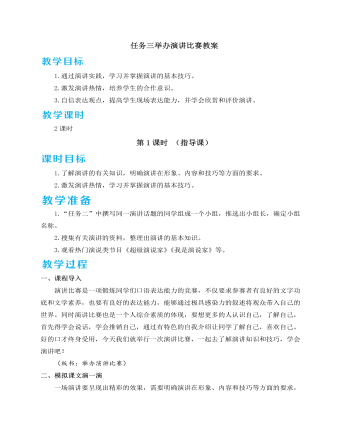
人教部编版语文八年级下册任务三举办演讲比赛教案
本环节通过评委宣布比赛规则和评分细则,为下面比赛活动中,学生学会欣赏和评价演讲打下基础。三、八仙过海赛一赛(主持人组织演讲比赛)演讲比赛的程序:1.各组参赛同学抽签,确定演讲顺序。2.参加比赛的同学按照顺序进行演讲,每位选手演讲完毕,评委现场打分。3.评委根据评分细则评分,去掉最高分和最低分,记分员核算出选手的平均分,并由主持人公布最后得分。4.每位参赛者演讲结束,评委和教师进行简要点评。5.第二轮由每组得分最高的选手进行即兴演讲拉票,决出班级前三名。6.主持人宣布比赛结果。7.活动结束。【设计意图】本环节通过演讲比赛和评价两个活动的交互进行,让学生进一步理解演讲技巧的具体运用方法,从而提高演讲能力。在整个演讲活动中,学生组织活动和实施活动的能力可以得到充分地展现和发挥。四、尺短寸长评一评1.精彩的演讲结束了,在这次演讲比赛中,给你留下深刻印象的演讲有哪些?请说明理由。(生自由发言,对演讲活动进行总结评价)2.在这次精彩的演讲比赛中,大家有哪些收获?请结合活动过程具体来谈。
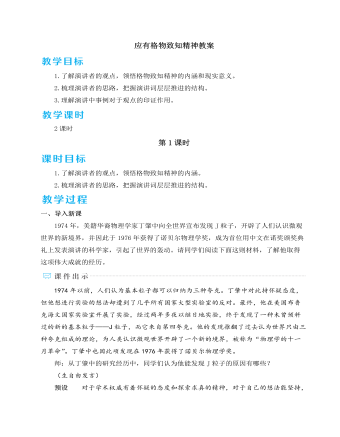
人教部编版语文八年级下册应有格物致知精神教案
1.了解演讲者的观点,领悟格物致知精神的内涵。2.梳理演讲者的思路,把握演讲词层层推进的结构。 一、导入新课 1974年,美籍华裔物理学家丁肇中向全世界宣布发现J粒子,开辟了人们认识微观世界的新境界,并因此于1976年获得了诺贝尔物理学奖,成为首位用中文在诺奖颁奖典礼上发表演讲的科学家,引起了世界的轰动。请同学们阅读下面这则材料,了解他取得这项伟大成就的经历。1974年以前,人们认为基本粒子都可以归纳为三种夸克。丁肇中对此持怀疑态度,但他想进行实验的想法却遭到了几乎所有国家大型实验室的反对。最终,他在美国布鲁克海文国家实验室开展了实验,经过两年多夜以继日地实验,终于发现了一种未曾预料过的新的基本粒子——J粒子,而它来自第四夸克。他的发现推翻了过去认为世界只由三种夸克组成的理论,为人类认识微观世界开辟了一个新的境界,被称为“物理学的十一月革命”。丁肇中也因此项发现在1976年获得了诺贝尔物理学奖。
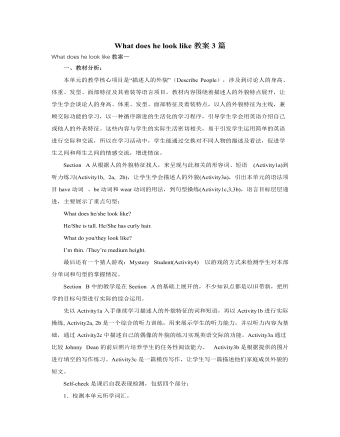
人教版新目标初中英语七年级下册What does he look like教案3篇
所需要用到的句子:Who is that?That is Jack. I like him.Why do you like him?I like him because he is interesting.Task 4: 设计理想中的人类Step one: 设计理想中的人类的外貌。把全班同学分成若干小组,学生可以边说边在纸上画出他们的模样。Step two: 设计理想中人类的性格。学生们可以把那些能描述性格的单词写在图画的旁边。Step three: 每组选出一名同学,其他同组同学提问,他作简单回答,并说明原因。所需用到的句子:What does he or she look like?He or she ...What is he or she like?He or she is ...Why?Because ...Task 5: 挑战性活动调查性格是天生的还是后天形成的,让每个同学回家去调查一下自己成长过程中性格是否有变化,具体是怎样的,为什么会这样? Teaching Aims:1. Enable students to have a general understanding of how to talk about people's physical appearance.2. Enable students to tackle some essential vocabularies and patterns about describing people. Provide them with necessary skills and methods.3. Create various chances for students to describe the persons they're familiar with, such as classmates, family members, teachers, idols, etc.

人教版新目标初中英语七年级下册Where is your pen pal from教案
2.1Match the country with the language.Step II Reading3a? let the students read the letter fast and answer the questions.? Let the students ask more questions about the letter as possible as the can.Step III Writing3b.Step IV. Pairwork2cStep V Listening2a, 2bStep V. HomeworkExercises book(1) P3Exercises book (2) P3Period FourStep I . Dictate the words and sentences in Unit1.Step II. Self-checkStep III. Check the answers for Exercises book in the unit.Step IV. Home workRevise and preparation for unit 2.教学反思:通过本单元的学习,学生基本可以谈论人们的国籍,居住城市及其所说的语言,通过书信方式去介绍自己并寻找笔友。但在涉及到国外的一些城市时,学生对这方面的知识相对欠缺,能介绍的城市并不多,也反应出学生课前预习不充分,这跟学生学习条件也有关,大多数学生无法通过网络获取所需信息。因此,在以后的教学中要多指导学生通过计算机网络获取信息,拓宽知识面。
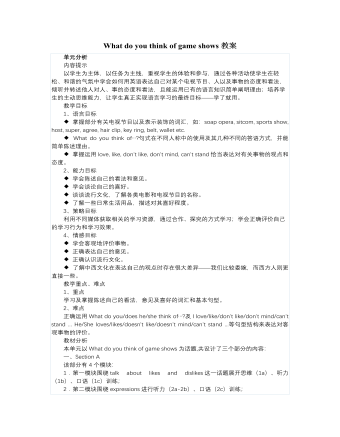
人教版新目标初中英语七年级下册What do you think of game shows教案
五、教学Section B-2c1. Pair work: What do you think of the belt/sunglasses/…? What does your father/mother/… think of your scarf/belt…?2. Group work(1). Teacher shows some different kinds of school uniforms (制服)and asks : “ What do you think of your school uniforms? If you have a chance to choose your school uniforms, what kind would you like to choose?”(2). Discuss in groups.(3).Get some Ss to report in class.说明:这一步旨在让学生运用已有的语言知识谈论对事物的看法和意见,并简单阐明理由,培养学生的主动思维能力和运用英语的能力。六、教学拓展调查电视节目的收视率任务:调查你周围的人对现在各种电视节目的反响。活动过程:1.教师布置任务,让学生调查周围的人(包括他的亲戚朋友和邻居)喜欢收看哪方面的电视节目。2.学生进行调查活动,运用本单元所学的句型What do you think of….? (Why?)What's your favorite game shows?What do you think of talk show?I doesn’t mind it.I like it.I love it.I can’t stand it.3.记录下排在前10位的TV Program,填写调查表,比较其收视率。
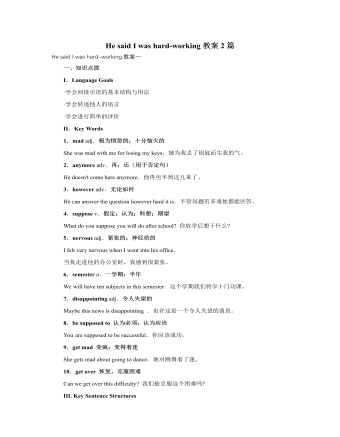
人教版新目标初中英语八年级下册He said I was hard-working教案2篇
This activity introduces some new vocabulary and provide oral practice using the target language.Task 1 . Ask four students to stand in front of the class, and the teacher asks them the following questions as a reporter.1.What are you going to do when you grow up?2.What are you going to do next week?3.What are going to do after school?The students will give different answers, then ask a good student to report what they said.I am going to e a doctor.What did she say?----------She said she was going to be a doctor.I am going to have a party on Friday night.What did he say?-------He said he was going to have a party on Friday night.I am going to do my homework.What did she say ?------ She said she was going to do her homework.I am going home after school.What did she say?-----She said she was going home after school.Say In this unit we are going to learn to use words like to report what someone said.Task 2. Read the instructions. Then ask a student to read the four questions. And write the words on the Bb. Explain what soap opera is.Task 3. Ask the students to Look at the pictures, point out the TV screens in the picture. Ask one girl to read what Marcia said.What did Marcia say? She said She said she was having a surprise party for Lana on Friday night. Repeat the other pictures in the same way.Activity3. Listen and number the pictures in activity 1a.
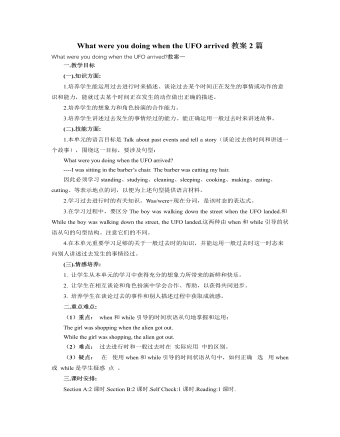
人教版新目标初中英语八年级下册What were you doing when the UFO arrived教案2篇
(一).知识方面: 1.培养学生能运用过去进行时来描述、谈论过去某个时间正在发生的事情或动作的意识和能力,能就过去某个时间正在发生的动作做出正确的描述。 2.培养学生的想象力和角色扮演的合作能力。 3.培养学生讲述过去发生的事情经过的能力。能正确运用一般过去时来讲述故事。 (二).技能方面: 1.本单元的语言目标是Talk about past events and tell a story(谈论过去的时间和讲述一个故事),围绕这一目标,要涉及句型: What were you doing when the UFO arrived? ----I was sitting in the barber’s chair. The barber was cutting my hair. 因此必须学习standing、studying、cleaning、sleeping、cooking、making、eating、cutting、等表示地点的词,以便为上述句型提供语言材料。2.学习过去进行时的有关知识。Was/were+现在分词,是该时态的表达式。 3.在学习过程中,要区分The boy was walking down the street when the UFO landed.和While the boy was walking down the street, the UFO landed.这两种由when和while引导的状语从句的句型结构。注意它们的不同。
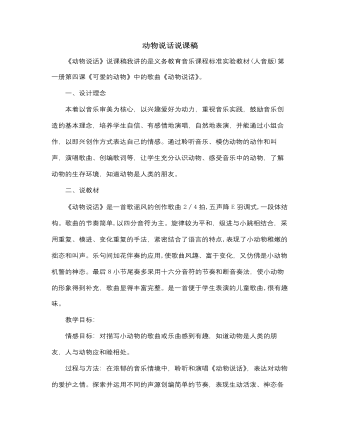
人音版小学音乐一年级上动物说话说课稿
6、总结师:听着小朋友们美妙的歌声,看着大家亲密无间的合作,老师的心里无比的快活。动物是人类的朋友,我们要保护动物,爱护动物。我想,小朋友的心情和老师心情是一样的,都很开心是吗?那么,为了表示大家高兴的心情,庆祝我们合作的愉快,我要邀请你们永远做我的朋友!(音乐起,师生一起跳舞《我们都是好朋友》)我邀请到谁,谁就可以再邀请与你合作愉快的小朋友。音乐反复到全体起立)让我们去操场邀请别的小朋友,告诉他们保护动物,爱护动物,走啦!(学生走出教室,本节教学结束)整个教学过程从一开始的律动,后来的动物模仿到创编节奏及即兴表演,运用感知法、认知法、学唱法,让学生用有感情的演唱和肢体语言表达对小动物的喜爱之情;通过创编,培养合作精神和创新能力,获得成功的喜悦。使学生的演、唱、创新、合作能力得到很好的发展,并渗透了思想教育。
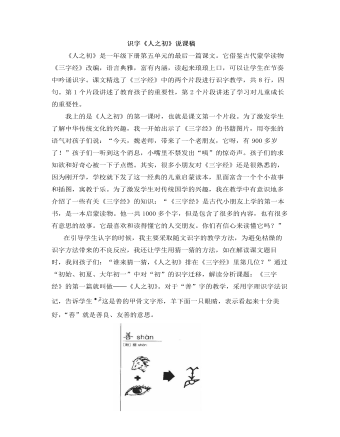
部编人教版一年级下册识字 《人之初》说课稿
我上的是《人之初》的第一课时,也就是课文第一个片段。为了激发学生了解中华传统文化的兴趣,我一开始出示了《三字经》的书籍图片,用夸张的语气对孩子们说:“今天,魏老师,带来了一个老朋友,它呀,有900多岁了!”孩子们一听到这个消息,小嘴里不禁发出“咦”的惊奇声。孩子们的求知欲和好奇心被一下子点燃。其实,很多小朋友对《三字经》还是很熟悉的,因为刚开学,学校就下发了这一经典的儿童启蒙读本,里面富含一个个小故事和插图,寓教于乐。为了激发学生对传统国学的兴趣,我在教学中有意识地多介绍了一些有关《三字经》的知识:“《三字经》是古代小朋友上学的第一本书,是一本启蒙读物。他一共1000多个字,但是包含了很多的内容,也有很多有意思的故事。它最喜欢和读得懂它的人交朋友。你们有信心来读懂它吗?”

部编人教版一年级下册识字 《猜字谜》说课稿
这篇课文很简单,而教师在传授这篇课文时的特色就是要在简单之中制造不简单,尝试着在快乐的猜谜语活动中交给孩子们一些规律性的东西,从而让他们在以后的生活和学习中得以运用。二、整体认知课文,学习生字1、自读课文,提问:在自读课文的时候,该注意些什么呢?不要限定学生的思维,引导孩子自主的关注朗读的技巧,并适时的给予指点和引导。2、学习生字。A提问:课文中有一些生字朋友,我们和他们打个招呼吧!(课件亮出生字)B请学生把难度、难认的字多读几遍。——请个别学生当老师,把难读的字和难记的字提选出来,教全班同学读和认记《语文课程标准》指出:语文教学应“注重培养学生自主学习的意识和习惯,为学生创设良好的自主学习情境。”在这一环节中,我将给学生创设一个自主的空间,让孩子自主地根据学生们自身的情况,确定难认和难读的字,把学习的主动权还给孩子。只要合情合理或有独到之处,就给予充分肯定,如果讲得不太合理,教师就给予适时点拨。
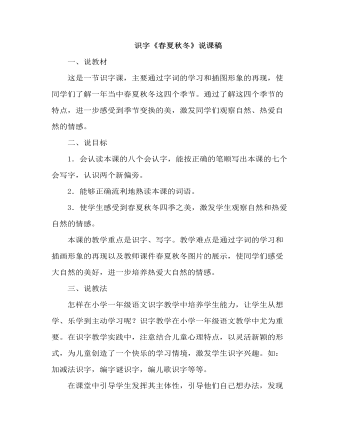
部编人教版一年级下册识字《春夏秋冬》(说课稿)
四、说过程为完成本课的教学目标,我设计了以下几个教学环节。(一)创设情境,揭示课题1.通过课件优美的图片分别展示春、夏、秋、冬四季的美景,请同学回答看到图片想到的是哪个季节,引出课题。2.板书课题:春夏秋冬。读题。3.学习会写字。理解“春”“冬”是四季中的两个季节,并指导写这两个字。(二)检查预习,引导初读1.自由读课文中的词语,圈划生字,读准字音。2.以小组为单位,讨论会写字的巧记方法。(三)重点品读,理解感悟1.感悟春夏秋冬四季。(1)教师领读词语“春飞吹、下雨落、秋霜降、冬雪飘”。教师课件展示四季美景。(2)学生感悟四季之美。(3)教师引导学生通过春、夏、秋、冬还能分别联想哪些景物和现象。(4)学生自己组织句子,用通顺的语言描述自己喜欢的季节和美景。
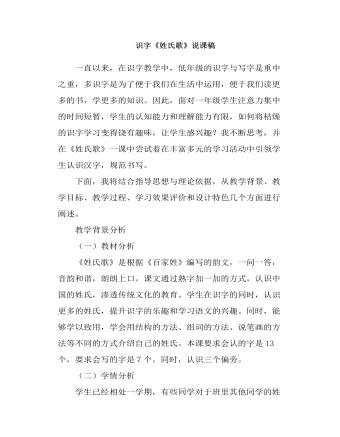
部编人教版一年级下册识字《姓氏歌》说课稿
(一)教材分析 《姓氏歌》是根据《百家姓》编写的韵文,一问一答,音韵和谐,朗朗上口。课文通过熟字加一加的方式,认识中国的姓氏,渗透传统文化的教育。学生在识字的同时,认识更多的姓氏,提升识字的乐趣和学习语文的兴趣。同时,能够学以致用,学会用结构的方法、组词的方法、说笔画的方法等不同的方式介绍自己的姓氏。本课要求会认的字是13个,要求会写的字是7个。同时,认识三个偏旁。 (二)学情分析 学生已经相处一学期,有些同学对于班里其他同学的姓名已经能认识,所以在学《姓氏歌》时,认识同学的姓,介绍自己的姓,这样的内容他们很感兴趣。通过创设丰富多彩的互动活动,引导学生改变被动接受知识的学习方式,在自主学习、主动探究的过程中感受语文学习的乐趣,让学生体验学习的快乐,将习得的方法用于互动交流,不断激发学习动力,真正成为学习的主人。
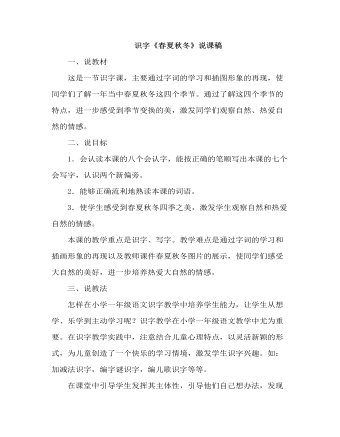
部编人教版一年级下册识字 《春夏秋冬》说课稿
(一)创设情境,揭示课题1.通过课件优美的图片分别展示春、夏、秋、冬四季的美景,请同学回答看到图片想到的是哪个季节,引出课题。 2.板书课题:春夏秋冬。读题。3.学习会写字。理解“春”“冬”是四季中的两个季节,并指导写这两个字。(二)检查预习,引导初读1.自由读课文中的词语,圈划生字,读准字音。2.以小组为单位,讨论会写字的巧记方法。(三)重点品读,理解感悟1.感悟春夏秋冬四季。(1)教师领读词语“春飞吹、下雨落、秋霜降、冬雪飘”。教师课件展示四季美景。(2)学生感悟四季之美。(3)教师引导学生通过春、夏、秋、冬还能分别联想哪些景物和现象。(4)学生自己组织句子,用通顺的语言描述自己喜欢的季节和美景。
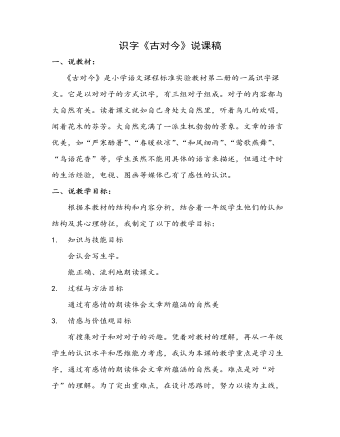
部编人教版一年级下册识字 《古对今》说课稿
三、说教法考虑到一年级学生的现状,我主要采取设置情景教学法,让学生积极主动地参与到教学活动中来,使他们在活动中得到认识和体验,产生践行的愿望。培养学生将课堂教学和自己的经验结合起来,引导学生主动去发现周边的客观事物。基于本课题的特点,我主要采用了以下的教学方法:直观演示法:利用图片等手段进行直观演示,激发学生的学习兴趣,活跃课堂气氛,促进学生对知识的掌握。四、说学法在整堂课教学,让学生在声情并茂的朗读中感受文本的美,早读中识字,在读中感悟,在读中积累、内化,在读中训练语言,来培养学生的朗读能力,表演能力也拓展了学生的思维能力,还培养了学生的自信心和主动探索、团结合作、勇于创新的精神。激发他们的情感,让他们在自主,合作,探究中学习语文,从中感受到学习语文的乐趣,更喜欢学习语文。五、说教学过程在这节课的教学过程中,我注重突出重点,条理清晰,紧凑合理,各项活动的安排也注重互动、交流,最大限度的调动学生参与课堂的积极性、主动性。

部编人教版一年级下册识字《猜字谜》(说课稿)
【说教材】我今天说课的内容是部编小学语文第二册《猜字谜》。这是两则猜字的谜语。生动有趣,语言优美,读起来朗朗上口。猜谜语寓知识性、趣闻性、哲理性于一体,能使学生主动参与,积极开动脑筋。结合本课、本单元的特点,以及《新课标》对知识与能力、过程与方法、情感态度与价值观三个纬度的要求,制定了以下3个学习目标:1.认识“相、遇”等12个生字。会写“字、右”等7个字。 2.朗读谜语,边读边想,总结猜谜语的好方法。3.培养学生收集谜语和自编谜语的兴趣。【说教法、学法】基于对教学目标、教材的分析,结合新课标的相关理念,我采用了自读感悟、自主探究、合作交流、实践创新等学习方式,努力构建开放而又有活力的新型语文课堂,始终把学生放在学习主人的地位,而教师则是学生学习的同行者、伙伴。 根据一年级学生的形象思维比较强、求知欲望强、对能激起他们的兴趣的东西感触深的特点,,我采用了情景教学、问题探究、直观教学等方法开展教学。
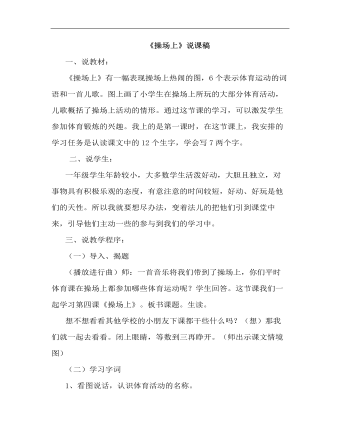
部编人教版一年级下册识字《操场上》(说课稿)
一、说教材:《操场上》有一幅表现操场上热闹的图,6个表示体育运动的词语和一首儿歌。图上画了小学生在操场上所玩的大部分体育活动,儿歌概括了操场上活动的情形。通过这节课的学习,可以激发学生参加体育锻炼的兴趣。我上的是第一课时,在这节课上,我安排的学习任务是认读课文中的12个生字,学会写7两个字。二、说学生:一年级学生年龄较小,大多数学生活泼好动,大胆且独立,对事物具有积极乐观的态度,有意注意的时间较短,好动、好玩是他们的天性。所以我就要想尽办法,变着法儿的把他们引到课堂中来,引导他们主动一些的参与到我们的学习中。
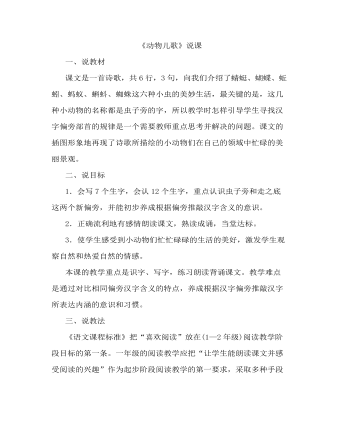
部编人教版一年级下册识字《动物儿歌》(说课稿)
一、说教材课文是一首诗歌,共6行,3句,向我们介绍了蜻蜓、蝴蝶、蚯蚓、蚂蚁、蝌蚪、蜘蛛这六种小虫的美妙生活,最关键的是,这几种小动物的名称都是虫子旁的字,所以教学时怎样引导学生寻找汉字偏旁部首的规律是一个需要教师重点思考并解决的问题。课文的插图形象地再现了诗歌所描绘的小动物们在自己的领域中忙碌的美丽景观。二、说目标1.会写7个生字,会认12个生字,重点认识虫子旁和走之底这两个新偏旁,并能初步养成根据偏旁推敲汉字含义的意识。2.正确流利地有感情朗读课文,熟读成诵,当堂达标。3.使学生感受到小动物们忙忙碌碌的生活的美好,激发学生观察自然和热爱自然的情感。本课的教学重点是识字、写字,练习朗读背诵课文。教学难点是通过对比相同偏旁汉字含义的特点,养成根据汉字偏旁推敲汉字所表达内涵的意识和习惯。
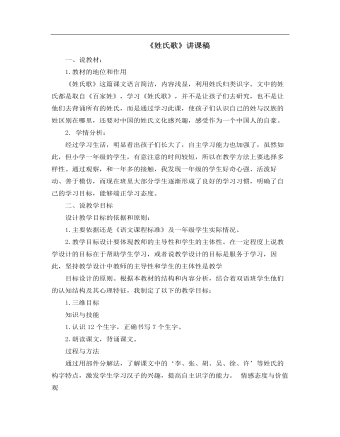
部编人教版一年级下册识字《姓氏歌》(说课稿)
一、说教材;1.教材的地位和作用《姓氏歌》这篇课文语言简洁,内容浅显,利用姓氏归类识字。文中的姓氏都是取自《百家姓》,学习《姓氏歌》,并不是让孩子们去研究,也不是让他们去背诵所有的姓氏,而是通过学习此课,使孩子们认识自己的姓与汉族的姓区别在哪里,还要对中国的姓氏文化感兴趣,感受作为一个中国人的自豪。2. 学情分析:经过学习生活,明显看出孩子们长大了,自主学习能力也加强了,虽然如此,但小学一年级的学生,有意注意的时间较短,所以在教学方法上要选择多样性。通过观察,和一年多的接触,我发现一年级的学生好奇心强、活泼好动、善于模仿,而现在班里大部分学生逐渐形成了良好的学习习惯,明确了自己的学习目标,能够端正学习态度。
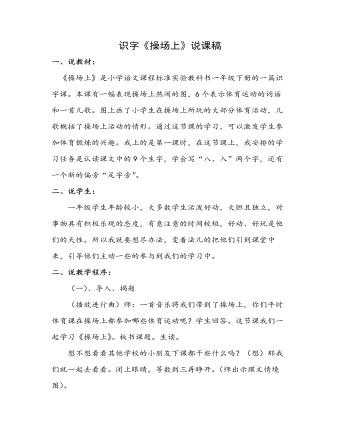
部编人教版一年级下册识字《操场上》说课稿
(二)、学习字词1、看图说话,认识体育活动的名称。师:看,操场上多热闹啊!这些小朋友都在干什么呢?(生:有的在跑步、有的在打球.......)师:你们说的真棒!老师告诉你们一个秘密,刚才你们说的体育活动中就藏着我们今天要学习的词语宝宝,咱们一起把他们读出来怎样?(师点击课件出示词语)2、这些词语你们认识吗?(如有认识的就请他读一读)不认识怎么办呢?利用拼音自已读一读,指名读、集体读。3、教师:去掉拼音小朋友们还认得这些字吗?我们来比一比看哪一组的小朋友反应最快了。利用课件,检查学生认读情况。4、组织学生看老师手里的卡片不出声做动作。5、小朋友看刚才我们学的词语中有的是用手做的动作,有的是用脚做的动作,那么请几个小朋友互相合作找一找哪些是用手做的动作,哪些是用脚做的动作?师生一起总结学习:“扌、足”。将字分类写在黑板上。
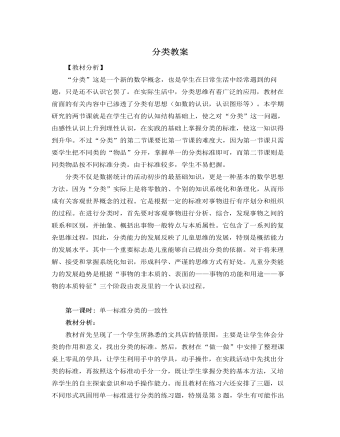
人教版新课标小学数学一年级上册分类教案
教学目标:1.能选择不同的标准对同一类物品进行不同的分类,掌握分类的方法。2.初步感知不同标准分类的意义,体验分类结果在不同标准下的多样性。3.培养学生思维的灵活性和发散性,养成良好的学习、生活习惯。4.培养学生的操作能力、观察能力、判断能力、语言表达能力和合作交流的意识。5.让学生体会到生活中处处有数学,学会用学到的知识解决生活中的实际问题。教学重、难点:重点:选择不同标准分类难点:思维的发散性 关键:在直观中拓展思维的时空教学准备:铅笔、实物卡片、学具袋(各种形状、颜色各异的物品)教学过程:一、观察分析 多重分类1.师出示如书本P39页的铅笔。(1)观察这些铅笔有什么不同?并把它们分分类。(2)四人一小组交流、讨论可以怎么分类?是按什么分的?比比哪一组的分法最多。



